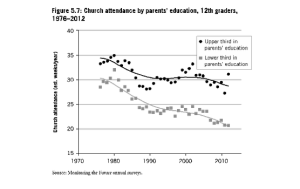“One possible force for greater upward mobility is the welfare reforms of the 1990s,” writes Manhattan Institute scholar Scott Winship in Forbes. “Hear me out, because I think the case is stronger than is generally admitted. We probably won’t know the answer for a few more years, because the oldest children born in the 1990s are only 25 years old today, and the youngest are barely 15 years old.” Nonetheless, what’s his case?
To begin with, liberals tend to believe that parental income per se is important for upward mobility. If true, welfare reform was far more effective than the War on Poverty at expanding opportunity. Child poverty, according to a carefully constructed measure developed by a Columbia University research team, was 26 percent in the peak year of 1969 and 27 percent in 1990 (also a peak). It continued rising until 1993, the year after a presidential campaign in which the winner routinely pledged to “end welfare as we know it” and the year that the Earned Income Tax Credit was substantially expanded by the new president. Child poverty then fell from 28 percent to 17 percent by 2006. It rose during the Great Recession, but not by much; 19 percent of children were poor in 2012.
Economic growth deserves some of the credit for the decline in child poverty; even without taking federal taxes and transfers into account, poverty would have fallen between 1993 and 2000. However, economic growth might not have actually lowered child poverty much if not for the work incentives built into welfare reform. The 1990s expansion was the first one since 1960 in which poverty among single-mother families responded as much to falling unemployment as it did among married-parent families, and poverty fell by more among single-mother families than their married-parent counterparts from 1996 to 2000. The strong economy of the late 1990s was fortuitous, but child poverty declined slightly even after 2000, rising only very modestly, if at all, during the two recessions since then.
…Through 1990, taxes and transfers had essentially no impact on the poverty rate they estimated. To be sure, the safety net moved some families up from deep poverty to less-intense hardship. But the Columbia poverty levels are pretty much the same from 1967 to 1990 whether or not the safety net is taken into account. Beginning in the early 1990s, however, taxes and transfers began to reduce child poverty rates below the levels they would otherwise have attained. The safety net was only effective at reducing poverty once the national mood was strongly in favor of fundamental reform and once those reforms began.
But was there an even bigger reason for the decrease in poverty? According to Winship, the answer (suggested by the evidence) has to do with intact families and a decrease in out-of-wedlock births. Check it out.
 …A 2013 study in The Journal of Regional Analysis and Policy by economists at Ohio University and Florida State University
…A 2013 study in The Journal of Regional Analysis and Policy by economists at Ohio University and Florida State University 


 The New York Times has a
The New York Times has a  Drawing on a large sample from Sweden, a new
Drawing on a large sample from Sweden, a new  Despite the Platonic ideal, ordinary people do not spend the majority of their time in the act of deep contemplation. Instead, they are performing the seemingly menial tasks of daily life. This largely consists of one’s form of employment. Finding meaning in the lone and dreary world of day-to-day work has been a point of increasing interest among management experts and organizational theorists. Their findings yield fruitful insights, especially given that one of Mormonism’s earliest forms of consecration was a business organization known as the United Firm. The “inspired fictionalization” of the United Firm revelations is an early example of Joseph Smith’s cosmological monism, transforming a business entity into the ancient “order of Enoch.” This sacralization of the mundane was further elaborated by Brigham Young and recognized by non-Mormons as an oddity of the Utahns. The metaphysical overlap of the temporal and spiritual realms can influence the way modern Mormons conduct their business, inspire “Zion-building” within organizations, and pave the way for a Mormon theology of work and eternal progression.
Despite the Platonic ideal, ordinary people do not spend the majority of their time in the act of deep contemplation. Instead, they are performing the seemingly menial tasks of daily life. This largely consists of one’s form of employment. Finding meaning in the lone and dreary world of day-to-day work has been a point of increasing interest among management experts and organizational theorists. Their findings yield fruitful insights, especially given that one of Mormonism’s earliest forms of consecration was a business organization known as the United Firm. The “inspired fictionalization” of the United Firm revelations is an early example of Joseph Smith’s cosmological monism, transforming a business entity into the ancient “order of Enoch.” This sacralization of the mundane was further elaborated by Brigham Young and recognized by non-Mormons as an oddity of the Utahns. The metaphysical overlap of the temporal and spiritual realms can influence the way modern Mormons conduct their business, inspire “Zion-building” within organizations, and pave the way for a Mormon theology of work and eternal progression.